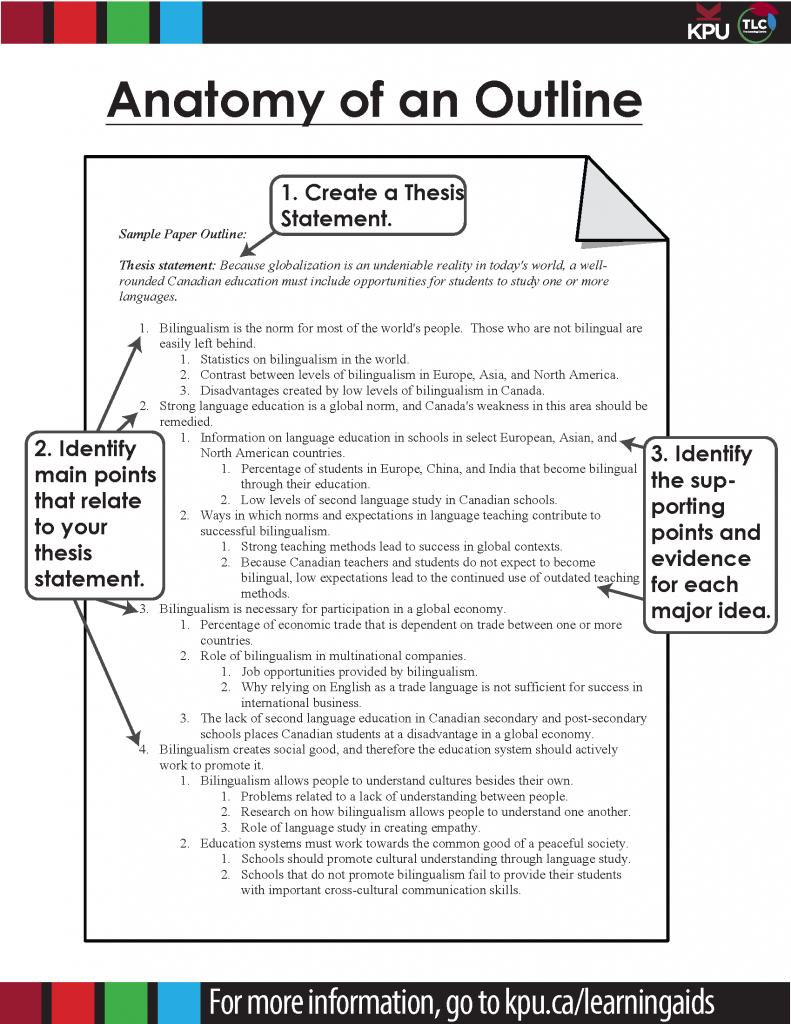Prewriting: Organizing and Outlining
29 Outlining
Outlining is a useful pre-writing tool when you know your topic well or at least know the areas you want to explore.
An outline can be written before you begin to write, and it can range from formal to informal. Many writers work best from a list of ideas or from freewriting, but you may have an assignment that is purely to create an outline.
(Note: A reverse outline can be useful once you have written a draft, during the revision process. For more on reverse outlining, see the “Revising” section.)
Traditional Outline
A traditional outline uses a numbering and indentation scheme to help organize your thoughts. Generally, you begin with your main point, stated as a topic sentence or thesis (see “Finding the Thesis” in the “Drafting Section”), and place the subtopics—the main supports for your topic sentence/thesis—and finally fill out the details underneath each subtopic. Each subtopic is numbered and has the same level of indentation. Details under each subtopic are given a different style of number or letter and are indented further to the right. It’s expected that each subtopic will merit at least two details.
Most word-processing applications include outlining capabilities. Try to create an outline with yours.
Here’s an example:
- Main Point
- Subtopic
- Detail/Evidence/Support
- Support/Example/Detail
- Supporting Idea
- Evidence/Support/Example
- Detail/Evidence/Support
- Example/Support/Evidence
- Subtopic
Outlining an Essay
Step 1: Create a thesis statement
If you are writing an essay or research paper, you will begin by writing a draft thesis statement. A thesis statement is a concise presentation of the main argument you will develop in your paper. Write the thesis statement at the top of your paper. You can revise this later if needed.
The rest of your outline will include the main point and sub-points you will develop in each paragraph.
Step 2: Identify the main ideas that relate to your thesis statement
Based on the reading and research you have already done, list the main points that you plan to discuss in your essay. Consider carefully the most logical order, and how each point supports your thesis. These main ideas will become the topic sentences for each body paragraph.
Step 3: Identify the supporting points and evidence for each major idea
Each main point will be supported by supporting points and evidence that you have compiled from other sources. Each piece of information from another source must be cited, whether you have quoted directly, paraphrased, or summarized the information.
Step 4: Create your outline
Outlines are usually created using a structure that clearly indicates main ideas and supporting points. In the example below, main ideas are numbered, while the supporting ideas are indented one level and labelled with letters. Each level of supporting detail is indented further.

Exercise
Create an outline for a paper or report for one of your courses.
- Write a thesis statement that clearly presents the argument that you will make.
- Use a multi-level outline, similar to the one in the example above, to create an outline before you begin writing.
Text Attributions
- This chapter was adapted from “Strategies for Getting Started” in The Word on College Reading and Writing by Carol Burnell, Jaime Wood, Monique Babin, Susan Pesznecker, and Nicole Rosevear, which is licensed under a CC BY-NC 4.0 Licence. Adapted by Allison Kilgannon.
- Text under “Outlining an Essay” was adapted from “Create an Outline” in University 101: Study, Strategize and Succeed by Kwantlen Polytechnic University Learning Centres, which is licensed under a CC BY-SA 4.0 Licence. Adapted by Allison Kilgannon.
Media Attributions
- “Anatomy of an Outline” by Graeme Robinson-Clogg is under a CC BY-SA 4.0 Licence.

